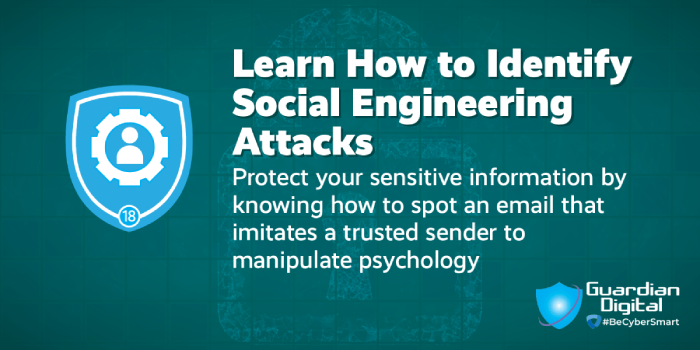Tip - Learn How To Identify Social Engineering Attacks

Protect your sensitive information by knowing how to spot an email that imitates a trusted sender to manipulate psychology.
Considering 98% of all cyber attacks rely on social engineering, we want to provide you with information on the topic and advice for protecting against social engineering attacks that you can use to safeguard your users and key business assets.
Social engineering refers to the use of deception to manipulate individuals into sharing confidential or personal information that can be used for fraudulent or malicious purposes. Criminals have been leveraging social engineering techniques for centuries; however, in recent years, the magnitude of this threat has increased exponentially.
Threat actors are now able to obtain extensive information on targets by searching the Internet - relying heavily on widely-used social media platforms for their research.
Like other cyber threats, social engineering attacks generally follow a standard lifecycle methodology that can be broken down into four clearly-defined steps:
Information Gathering: Threat actors identify a target, employ Open Source Intelligence Techniques (OSINT) to gather as much information on the target as possible and select the attack method(s) they will use.
Establish Relationship: Cyber criminals engage with the victim though targeted communications such as social media messages or spear phishing emails.
Exploitation: Attackers use information and the relationship they’ve built with the target to gain a ‘foothold’ (i.e. giving away sensitive information).
Attack Execution: Threat actors perform the attack - carefully erasing any digital footprints (such as malware) in order to remain undetected.
The majority of social engineering attacks are so targeted and deceptive that it has become difficult to blame a user for falling for a scam. After all, even the most security-conscious individuals can be tricked by social engineering. Thus, defending against social engineering attacks requires a comprehensive, fully-managed email security solution capable of anticipating and blocking advanced and emerging threats in real-time and preventing all malicious mail from being delivered, creating a safeguarded environment around the user.
Want to learn more about securing your data and your brand against social engineering attacks? Get in Touch >>
CyberSecurity Month
- Tip - Avoid Phishing Emails
- Tip - Being Cautious of Spam Email
- Tip - Be Wary of Malicious URLs
- Tip - Protect Against Spoofing & Sender Fraud
- Tip - Protect the Privacy of Your Email with TLS
- Tip - Don't Rely on Native Microsoft 365 Email Protection Alone
- Tip - Implement TLS to Keep Your Email Secure
- Tip - Endpoint Security Is Not Enough
- Tip - Conduct Regular Email Security Audits
- Tip - Configure Email Account Settings with Security in Mind
- Tip - Learn How To Spot Threats to Business Email
- Tip - Backing up Your Data and Isolate Your Backups Offline
- Tip - Protect Business Email from Phishing Attacks
- Avoid Sending Sensitive Information Over Email
- Tip - Learn About Malicious Links
- Tip - Prevent Zero-Day Attacks
- Tip - Business Email Is for Business Only
- Tip - Learn How To Identify Social Engineering Attacks
- Tip - Know Your Email Risk
- Tip - Safeguard Your Inbox from Malicious Mail
- Tip - Understand How Phishing Attacks Are Carried Out
- Tip - Know the Steps in a Spear Phishing Attack
- Tip - Familiarize Yourself with the Anatomy of a Whaling Attack
- Tip - Understand How Malware Attacks Work
- Tip - Learn the Steps in a Ransomware Attack
- Tip - Understand the Phases of a Business Email Compromise (BEC) Attack
- Tip - Know What Zero-Day Attack Is & How It Works
- Tip - Familiarize Yourself with the Phases of an Account Takeover (ATO) & Lateral Phishing Attack
- Tip - Learn the Steps in a Social Engineering Attack
- Tip - Understand the Types of Email Viruses to Be on the Lookout For